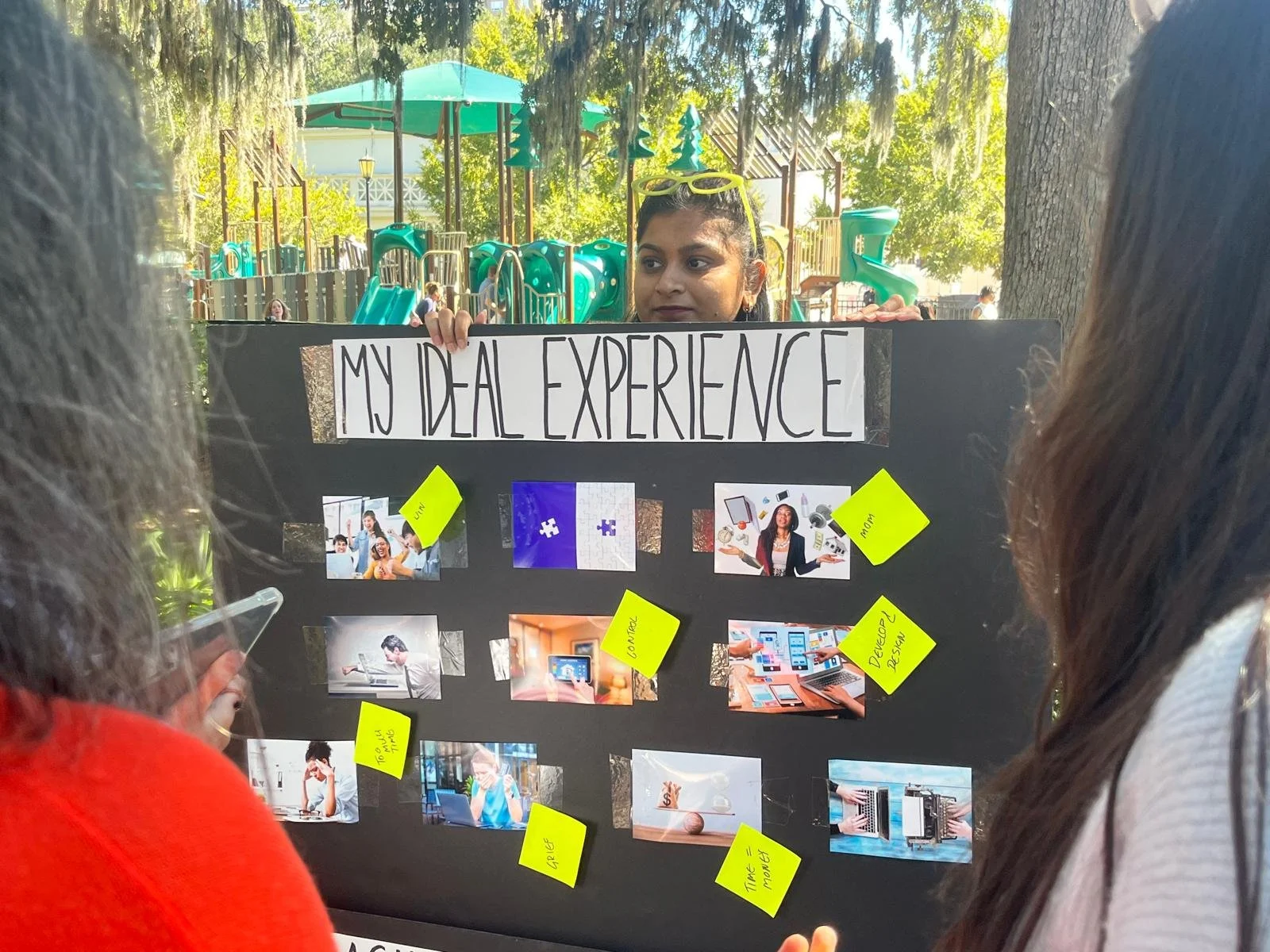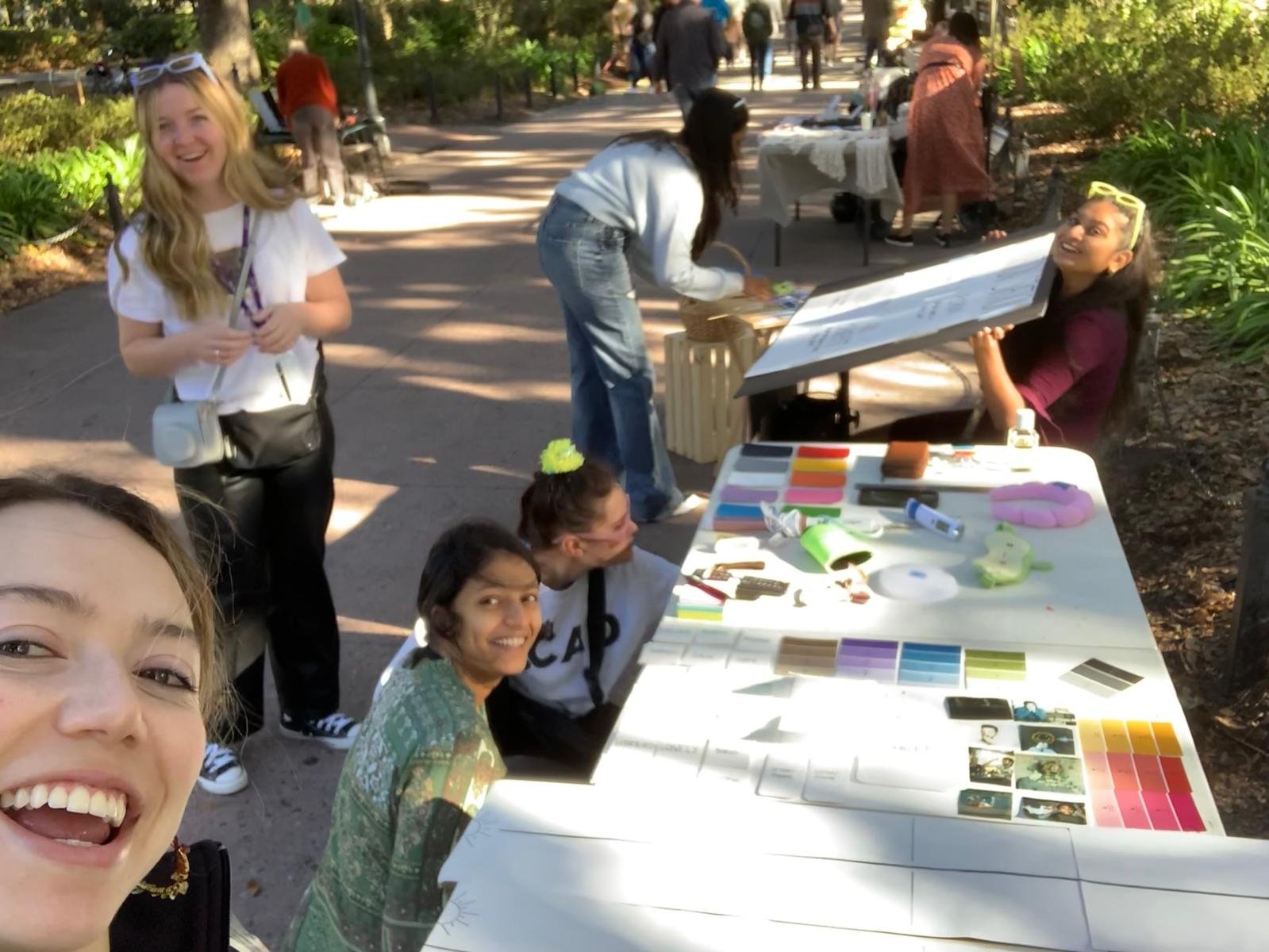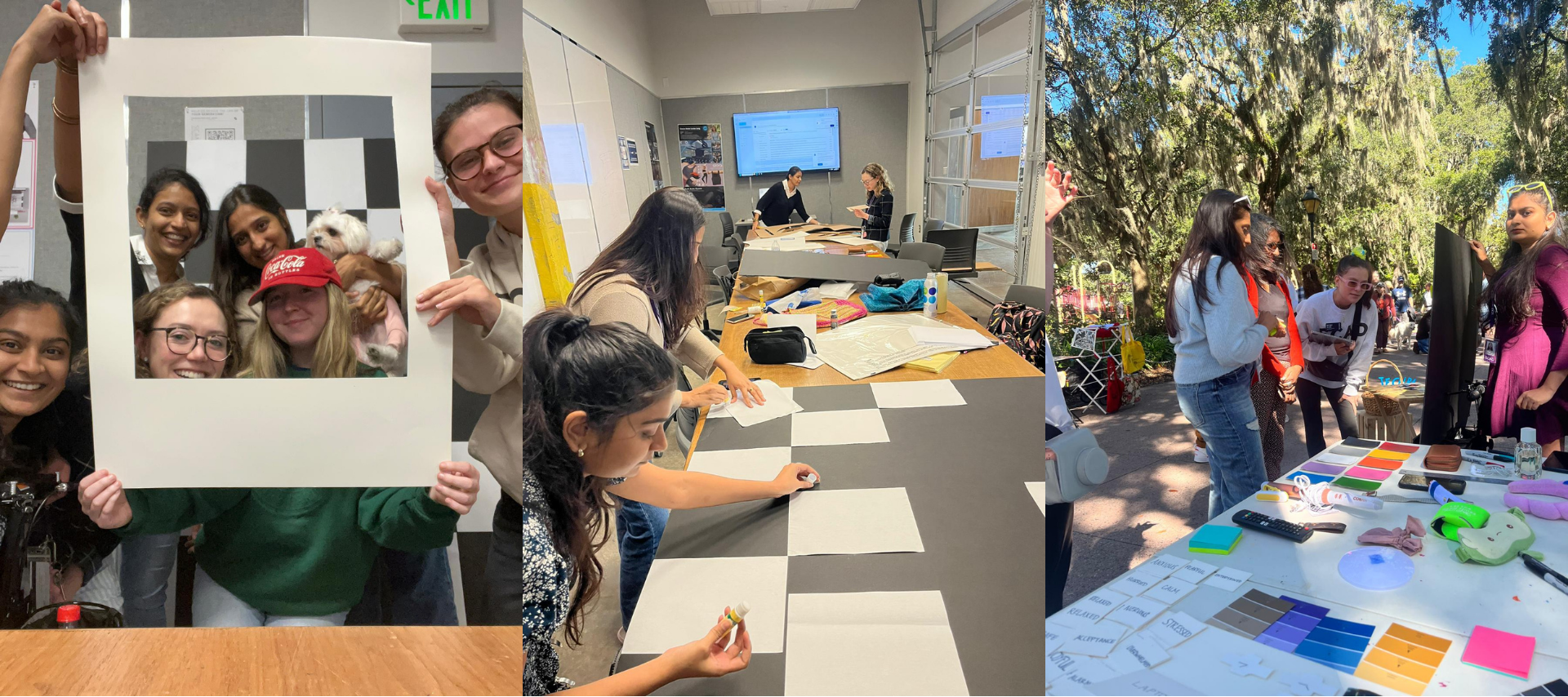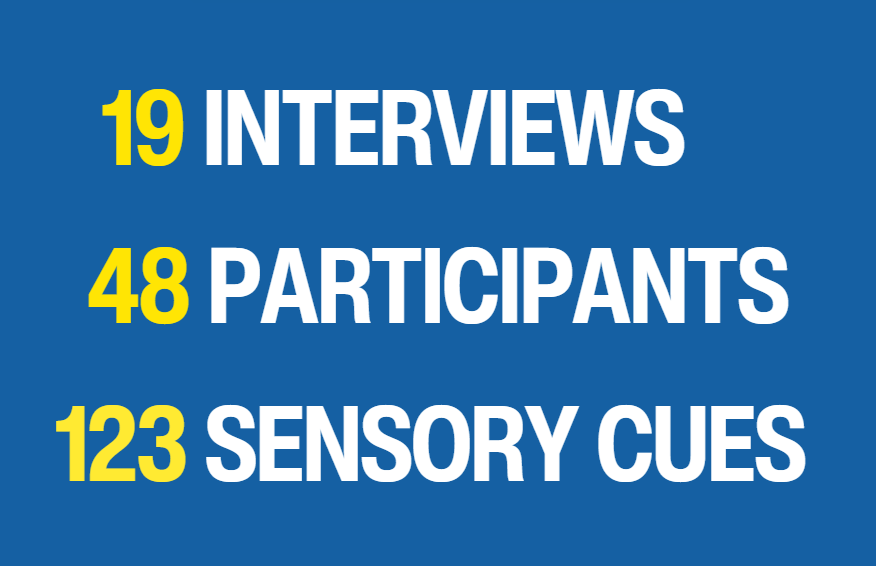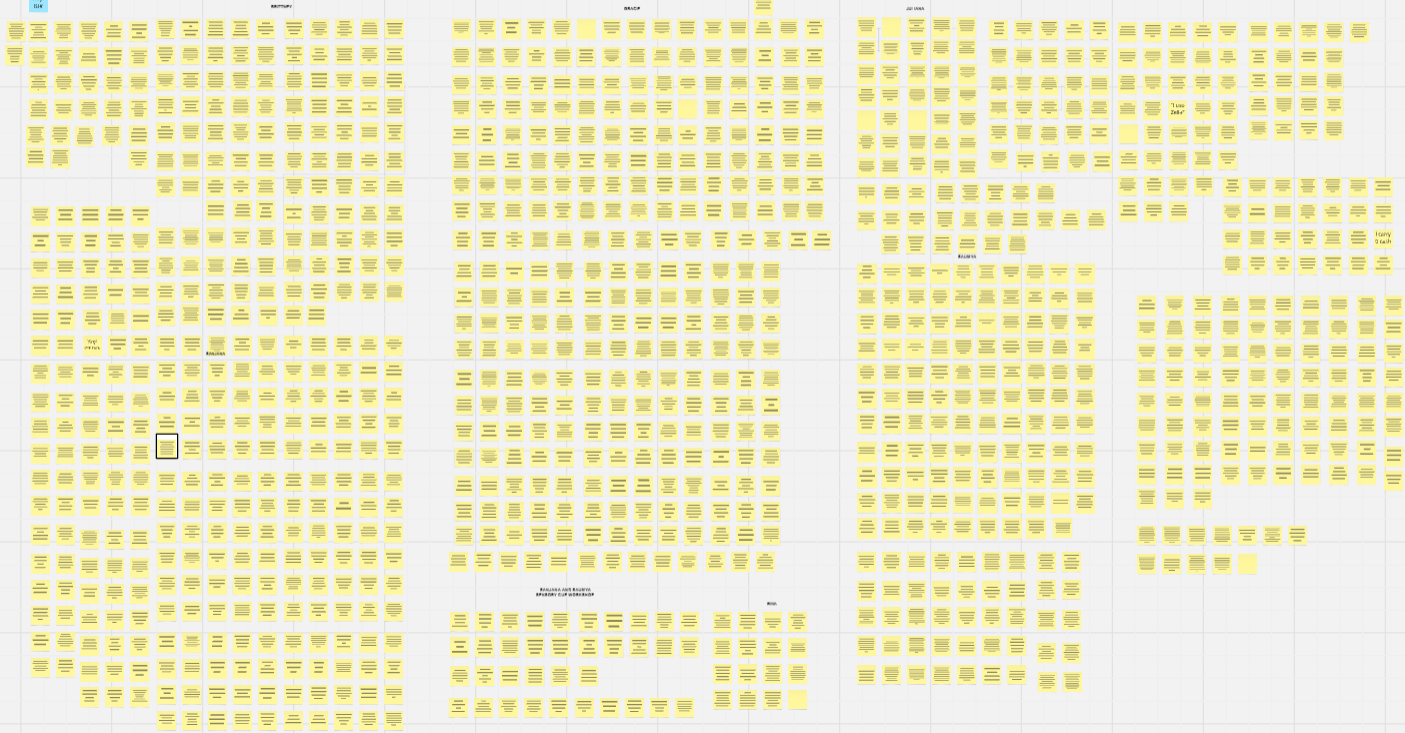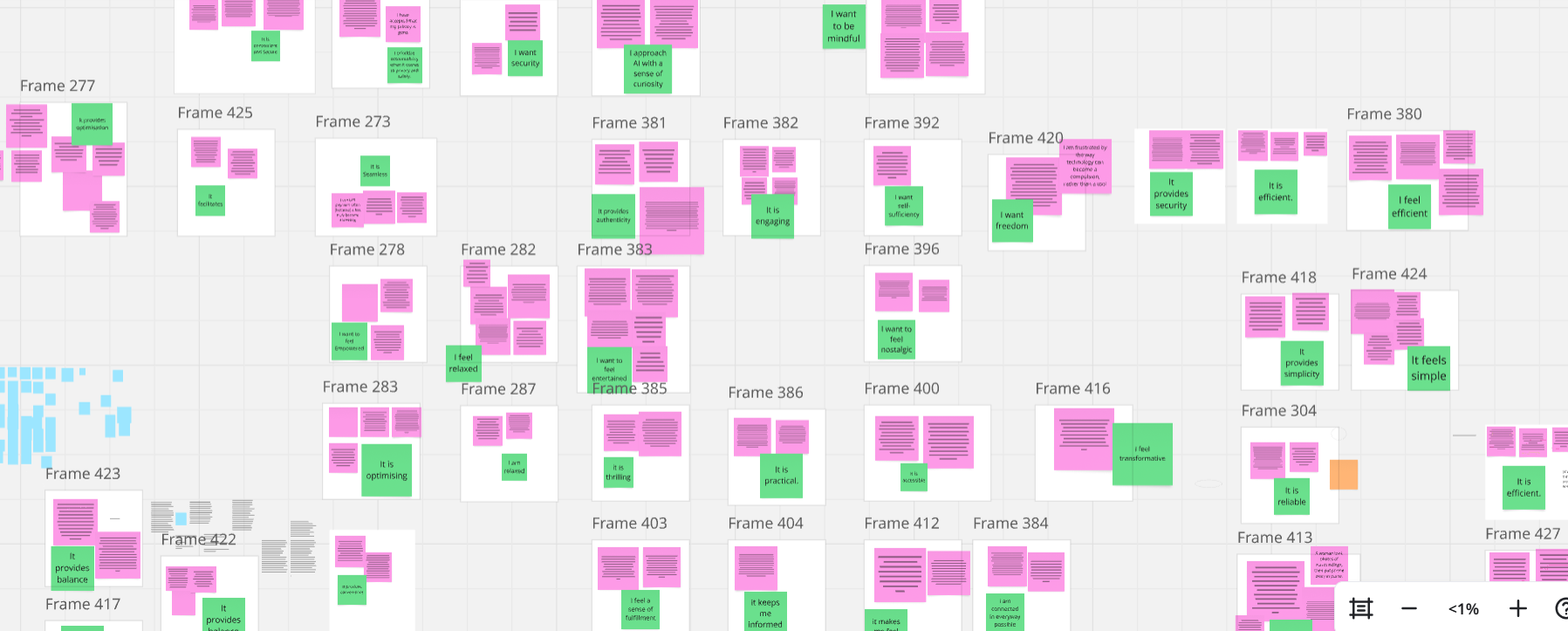My Role
UX researcher
Observations, interviews, and sensory workshops.
Goal
The goal was to explore Generation X’s technology interaction, identifying their needs and challenges to inform user-centered design.
Impact of the Project
It helps bridge the gap between innovation and user expectations, leading to more empowering solutions.
Duration
10 weeks
Tools
Solution
This project explores Generation X’s technology use, identifying their needs for user-centered design. Through observations, interviews, and sensory workshops, we found a preference for balanced, secure, and practical technology that enhances digital well-being. Using the Anatomy of Experience Framework, we developed actionable design strategies to create intuitive, empowering experiences.
Final Deliverable
Experience Framework, Client Magazine
Lextant Design Thinking Framework
Lextant's framework is a user-centered design approach that uses visual research to uncover user needs and behaviors. It guides designers through a step-by-step process to identify key themes, emotions, and responses, ensuring designs are intuitive and impactful. For our project, we used this framework to explore Generation X's tech needs, focusing on balance, security, and digital well-being. By following Lextant’s structured approach, we gained valuable insights that bridged the gap between user expectations and technology, helping us create more meaningful, user-centered solutions. This method was essential in driving our research and design outcomes.
Screening & Interviewing
Based on our observations, we created a screener and a discussion guide. We then conducted in-depth interviews with 19 individuals. The interviews ranged from 30 to 60 minutes in length. While most of the participants are unaffiliated with SCAD, a few are SCAD staff members.
Research Methods
Research Observations
We conducted our observational research at various locations in Savannah, Georgia, including the Farmer's Market, Best Buy, River Street, Foxy Loxy Cafe, Kroger’s, Colonial Park, and Starbucks as well as EarthCam. Each observer spent an hour at each location, resulting in a total of 48 individuals.
Analysis
We all gathered data points and notes, which were meticulously documented and organized for a comprehensive review. Affinization sessions involving field and strategy teams were conducted to structure the work into dominant themes and big ideas.
Sensory Cue Workshop
We distributed the sensory cue kit on October 21, 2023, at Forsyth Park. The kit comprises approximately 91 items. Ten participants engaged with the kit, each spending an average of 30 to 45 minutes exploring the sensory items.
-
Shoppers actively engaged with tech devices like smartphones, laptops, and smart TVs.
Many explored product features and consulted sales associates for recommendations.
Prioritized functionality and user-friendliness over novelty in purchasing decisions.
In-store displays were used to interact with devices and test features before purchase.
-
People balanced phone usage with in-person socializing in public spaces.
Mobile devices used for taking photos, navigation, or checking notifications.
Gen X individuals consciously limited device usage to focus on in-person interaction.
Mobile tech often used for navigation and location-based activities (e.g., finding restaurants).
KEY OBSERVATIONS
-
Mobile payments (e.g., Apple Pay, Google Wallet) were preferred for quick transactions.
Devices were used for casual social media updates and sharing experiences with others.
Tech was used for convenience, such as browsing menus, making payments, or staying connected during breaks.
-
Remote observations revealed behaviors in both retail and informal public settings.
Tech use was prevalent for navigation, social interaction, and capturing moments.
Public space users often interacted with tech to stay connected or engage in social media.
Despite tech usage, many still prioritized face-to-face interactions in public settings.
RESEARCH INTERVIEW PROCESS
1
Formulating Questions
For our group project on Generation X’s ideal tech experience, we focused on key objectives such as understanding their technology usage, privacy concerns, and work-life balance. We developed targeted questions based on these objectives, such as:
How do you feel about privacy when using digital devices?
What factors influence your decision to adopt new technology?
2
Creating a Discussion Guide
We structured our interviews with a discussion guide, which helped keep the conversation focused and flowing. The guide included sections like:
Technology Usage
Digital Privacy & Security
Work-Life Balance
User Preferences & Pain Points
Future of Technology
3
Conducting Interviews
Moderating the interviews, we focused on active listening, flexibility, and creating an engaging environment. We adapted the conversation to explore interesting insights while ensuring we covered all key areas. Our goal was to gather valuable, authentic feedback on Generation X's tech experiences.
INTERVIEW QUOTES
“It all begins with an idea. Maybe you want to launch a business.”
William Jones
“The ideal app or device would empower people to achieve their peak productivity and form meaningful connections.”
Paula Smith
“Finding a balance between technology and unplugging is essential for our well-being.”
Jennifer Lee
“Apple's ecosystem is so tightly integrated that users feel compelled to use all of its products.”
Keith Finley
“I feel unsafe having my financial information on the internet, but I accept it as a necessary evil.”
Allen W.
“The device or app should be seamlessly integrated with the rest of your technology ecosystem.”
Chhaya Shinde
SENSORY CUE WORKSHOP
Research Observations
For understanding Generation X’s ideal technology experience, we conducted a sensory cue workshop at Savannah’s Forsyth Park, in the Farmer’s Market. The workshop was designed with four stations to engage participants and gather insights through sensory interaction.
Iconic Technology Devices: Participants recalled devices from their past, evoking nostalgic memories of their youth.
Mapping Daily Technology Usage: They mapped out their daily tech use and its emotional effects, helping us understand how technology impacts their lives.
To enhance emotional connection, we played music from the participants’ time, which helped them feel more engaged and connected during the workshop. These steps provided a comprehensive understanding of Generation X's technology preferences, informing our design recommendations.
Ideal Technology Experience: Participants described their ideal tech experience using sticky notes, revealing key words that shaped their vision for the future.
Device Interaction: They interacted with different devices, selecting their favorites and explaining their preferences for usability and design.
AFFINITY MAPPING PROCESS
Research Observations
The Lextant affinity mapping process organizes raw data into meaningful insights by grouping ideas through multiple stages, from yellow post-its capturing initial thoughts to green post-its summarizing final themes. This method helps identify patterns and themes, ensuring that all data is thoroughly reviewed and refined. It is effective in providing clarity and structure, allowing teams to make informed, user-centered design decisions.
1
4
Raw Data Collection:
We gathered raw data from various sources, including interviews, surveys, and observations. This information was initially written on yellow post-it notes, capturing individual thoughts, needs, and experiences related to Generation X's tech usage.
2
Grouping Initial Ideas:
The yellow post-its were reviewed and grouped based on common themes or related ideas. These initial clusters helped us identify recurring patterns and concepts.
Second-Level Affinitization:
Each cluster was summarized on a blue post-it note, representing a more refined level of categorization. These blue notes helped us pinpoint broader themes and emerging patterns within the data.
3
Identifying Sub-Themes:
We further refined each theme by identifying sub-themes within the blue post-its. This involved analyzing the data more closely to uncover specific aspects of each broader theme, which we summarized on pink post-its.
Final Theme Categorization:
The pink post-its were grouped into final themes and insights, represented by green post-its. These green notes captured the core themes that informed our recommendations for the ideal technology experience for Generation X.
5
The final step in the Lextant affinity mapping process was to identify key words from the green post-its, which were then finalized on orange sticky notes. This helped to highlight the most important insights and themes that emerged from the data. These key words guided the creation of actionable design recommendations and a clearer understanding of user needs.
EXPERIENCE FRAMEWORK
This visual framework illustrates the ideal technology experience for Generation X by organizing their key needs into three circles:
Inner Circle (I Feel Balanced): The core desire for balance between technology and personal well-being, emphasizing a harmonious relationship with tech.
Middle Circle (I Am): Terms like Safe, Connected, Mindful, Efficient, and Practical reflect Generation X's desire for intuitive, reliable technology that enhances life without overwhelming it.
Outer Circle (I Want): Features such as Privacy, Entertainment, Convenience, and User Friendly capture specific tech attributes they seek, prioritizing practicality, ease of use, and personal connection.
In the Lextant framework, enablers are the features like notification sounds, speed, and color coding that make the core themes possible, ensuring technology is both usable and aligned with Generation X’s preferences.



















